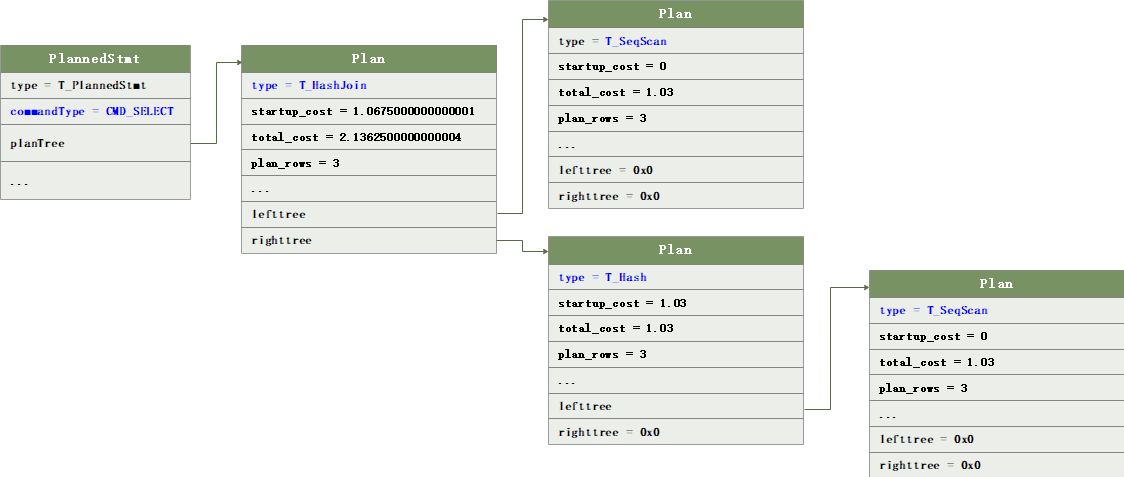openGauss 内核分析:执行计划生成
- 2022 年 8 月 29 日 中国香港
本文字数:2571 字
阅读完需:约 8 分钟

本文分享自华为云社区《openGauss内核分析(六) 执行计划生成》,作者:Gauss 松鼠会。
SQL 语句解析完成后被解析成 Query 结构,在进行优化时是以 Query 为单位进行的,Query 的优化分为基于规则的逻辑优化(查询重写)和基于代价的物理优化(计划生成),主入口函数为 subquery_planner。subquery_planner 函数接收 Query(查询树),返回一个 Plan(计划树)。
Plan* subquery_planner(PlannerGlobal* glob, Query* parse, PlannerInfo* parent_root, bool hasRecursion, double tuple_fraction, PlannerInfo** subroot, int options, ItstDisKey* diskeys, List* subqueryRestrictInfo){ PlannerInfo* root = NULL;Plan* plan = NULL; //返回结果…preprocess_const_params(root, (Node*)parse->jointree); // 常数替换等式… if (parse->hasSubLinks) { pull_up_sublinks(root); //提升子链接 DEBUG_QRW("After sublink pullup"); } /* Reduce orderby clause in subquery for join */ reduce_orderby(parse, false); //减少orderby DEBUG_QRW("After order by reduce"); if (u_sess->attr.attr_sql.enable_constraint_optimization) { removeNotNullTest(root); //删除NotNullTest DEBUG_QRW("After soft constraint removal"); }… if ((LAZY_AGG & u_sess->attr.attr_sql.rewrite_rule) && permit_from_rewrite_hint(root, LAZY_AGG)) { lazyagg_main(parse); // lazyagg重写 DEBUG_QRW("After lazyagg");}…parse->jointree = (FromExpr*)pull_up_subqueries(root, (Node*)parse->jointree); //提升子查询… if (parse->setOperations) { flatten_simple_union_all(root); //UNIONALL优化 DEBUG_QRW("After simple union all flatten");}…expand_inherited_tables(root); //展开继承表…parse->targetList = (List*)preprocess_expression(root, (Node*)parse->targetList, EXPRKIND_TARGET); //预处理表达式…parse->havingQual = (Node *) newHaving; //处理HAVING子句… reduce_outer_joins(root); //外连接消除… reduce_inequality_fulljoins(root); //全连接重写 …plan = grouping_planner(root, tuple_fraction); //主要的计划过程…return plan;}subquery_planner 函数由函数 standard_planner 调用,standard_planner 函数由 exec_simple_query->pg_plan_queries->pg_plan_query->planner 函数调用。standard_planner 将 Query(查询树)生成规划好的语句,可用于执行器实际执行。
PlannedStmt* standard_planner(Query* parse, int cursorOptions, ParamListInfo boundParams){ PlannedStmt* result = NULL; //返回结果PlannerGlobal* glob = NULL; double tuple_fraction; PlannerInfo* root = NULL;Plan* top_plan = NULL;… glob = makeNode(PlannerGlobal); /* primary planning entry point (may recurse for subqueries) */top_plan = subquery_planner(glob, parse, NULL, false, tuple_fraction, &root); //主规划过程入口… /* build the PlannedStmt result */result = makeNode(PlannedStmt); //构造PlannedStmtresult->commandType = parse->commandType;result->queryId = parse->queryId;result->uniqueSQLId = parse->uniqueSQLId;result->hasReturning = (parse->returningList != NIL);result->hasModifyingCTE = parse->hasModifyingCTE;result->canSetTag = parse->canSetTag;result->transientPlan = glob->transientPlan;result->dependsOnRole = glob->dependsOnRole;result->planTree = top_plan; //执行计划result->rtable = glob->finalrtable;result->resultRelations = glob->resultRelations;… return result;}仍然以前文的 join 列子来说明
SELECT * FROM t1 inner JOIN t2 ON t1.c1 = t2.c1;在 planner 函数打断点,用 gdb 查看 standard_planner 返回的 PlannedStmt
(gdb) bt#0 planner (parse=0x7fd93a410288, cursorOptions=0, boundParams=0x0) at planner.cpp:389#1 0x0000000001936fbd in pg_plan_query (querytree=0x7fd93a410288, cursorOptions=0, boundParams=0x0, underExplain=false) at postgres.cpp:1197#2 0x0000000001937381 in pg_plan_queries (querytrees=0x7fd939b81090, cursorOptions=0, boundParams=0x0) at postgres.cpp:1315#3 0x000000000193a6b8 in exec_simple_query (query_string=0x7fd966ad2060 "SELECT * FROM t1 inner JOIN t2 ON t1.c1 = t2.c1;", messageType=QUERY_MESSAGE, msg=0x7fd931056210) at postgres.cpp:2560#4 0x0000000001947104 in PostgresMain (argc=1, argv=0x7fd93a2cf1c0, dbname=0x7fd93a2ce1f8 "postgres", username=0x7fd93a2ce1b0 "test") at postgres.cpp:8403#5 0x0000000001890740 in BackendRun (port=0x7fd931056720) at postmaster.cpp:8053#6 0x00000000018a00b1 in GaussDbThreadMain<(knl_thread_role)1> (arg=0x7fd97c55c5f0) at postmaster.cpp:12181#7 0x000000000189c0de in InternalThreadFunc (args=0x7fd97c55c5f0) at postmaster.cpp:12755#8 0x00000000024bf7d8 in ThreadStarterFunc (arg=0x7fd97c55c5e0) at gs_thread.cpp:382#9 0x00007fd9a60cfdd5 in start_thread () from /lib64/libpthread.so.0#10 0x00007fd9a5df8ead in clone () from /lib64/libc.so.6(gdb) p *result$14 = {type = T_PlannedStmt, commandType = CMD_SELECT, queryId = 0, hasReturning = false, hasModifyingCTE = false, canSetTag = true, transientPlan = false, dependsOnRole = false, planTree = 0x7fd93a409d58, rtable = 0x7fd939b81660, …}(gdb) p *result->planTree->lefttree$46 = {type = T_SeqScan, plan_node_id = 2, parent_node_id = 1, exec_type = EXEC_ON_DATANODES, startup_cost = 0, total_cost = 1.03, plan_rows = 3, multiple = 1, plan_width = 8,…}将 Query 规划后得到 PlannedStmt


可以看到,Plannedstmt 与 explain 执行计划是一致的

版权声明: 本文为 InfoQ 作者【华为云开发者联盟】的原创文章。
原文链接:【http://xie.infoq.cn/article/074ddc0413c06ff2ceb4e7c6b】。文章转载请联系作者。
华为云开发者联盟
提供全面深入的云计算技术干货 2020.07.14 加入
华为云开发者社区,提供全面深入的云计算前景分析、丰富的技术干货、程序样例,分享华为云前沿资讯动态,方便开发者快速成长与发展,欢迎提问、互动,多方位了解云计算! 传送门:https://bbs.huaweicloud.com/










评论